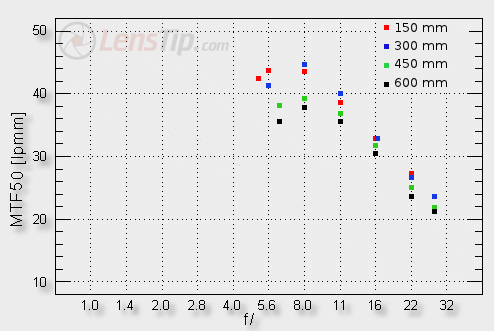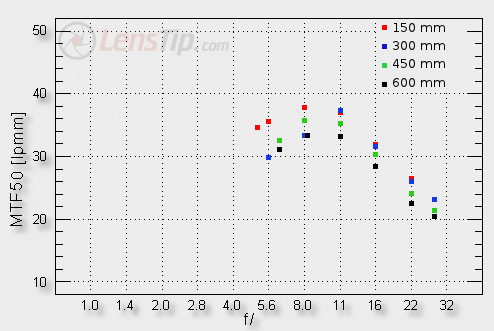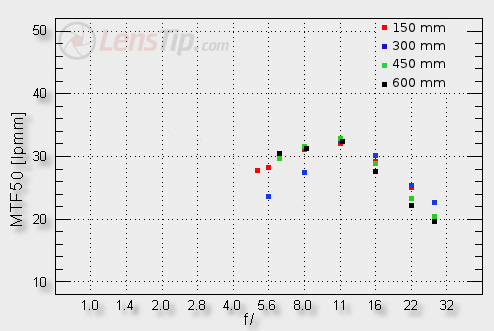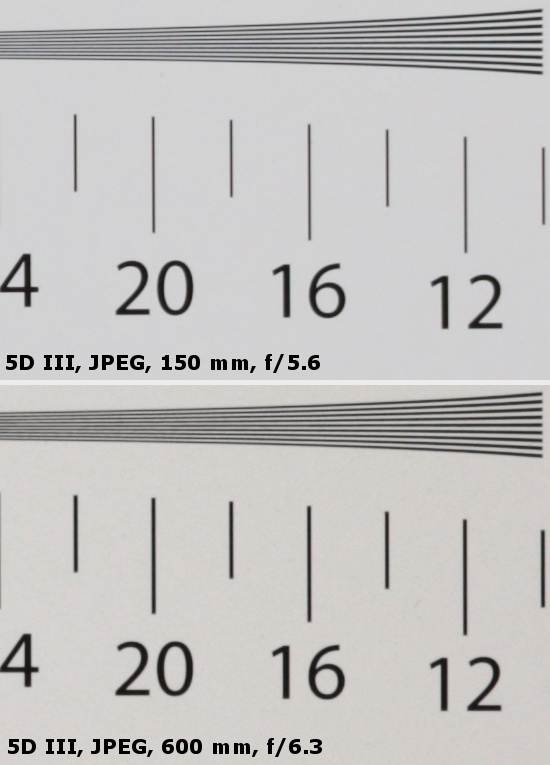Sigma S 150-600 mm f/5-6.3 DG OS HSM
4. Image resolution
The graph below shows the performance of the tested lens in the frame centre at 150, 300, 450 and 600 mm.

Please Support UsIf you enjoy our reviews and articles, and you want us to continue our work please, support our website by donating through PayPal. The funds are going to be used for paying our editorial team, renting servers, and equipping our testing studio; only that way we will be able to continue providing you interesting content for free. |
- - - - - - - - - - - - - - - - - - - - - - - - - - - - - - - - - - - - - - - - - - - - - - - -
Two groups of results can be distinguished here: a bit higher in the 150-300 mm range and lower in the 450-600 mm range. The first group just makes you want to clap and cheer – a sensation! Already at the maximum relative aperture the lens exceeds 40 lpmm with ease so the images are of perfect quality. On slight stopping down the lens reaches 44 lpmm. It’s enough to remind here that such well-known and much-liked lenses as the Canon EF 2/135L and the Canon 2.8/200L had similar results near f/5.6-8.0 apertures to realize how good a performance it really is. It shows that lately the optics has undoubtedly progressed by leaps and bounds and the new Sigma is a very good instrument.
In this range the Sigma fares noticeably better than the Tamron SP 150-600 mm f/5-6.3 Di VC USD which, at the maximum relative aperture, had results close to 38 lpmm, exceeding slightly 40 lpmm on stopping down.
Now the 450–600 mm range: the MTFs are lower but still you don’t have any reason to complain, quite the opposite. These are still very goo values. Already the maximum relative aperture provides fully sharp images and when you stop down the lens the MTFs reach 38-39 lpmm. Once again this performance is better than that of the Tamron; still the difference doesn’t seem huge. It should be also mentioned that the Sigma at 450 mm fares better than the Canon EF 100-400 mm f/4.5–5.6 L IS USM fared at 400 mm – it’s time for changes!
Now let’s check the situation on the edge of the APS-C sensor.

The lack of weak points becomes conspicuous at once. The lowest result at the maximum relative aperture is reached at 300 mm but even there the MTFs brush against 30 lpmm so the image quality can be deemed satisfactory. Other combinations of focal lengths and apertures are only better; at 150 mm on stopping down you can even go as high as almost 38 lpmm.
In the case of the Tamron 150-600 mm the maximum results were similar but the 600 mm focal length was a bit of a problem – at the maximum aperture you landed below the decency level and stopping down the lens helped just slightly.
Once again out of three lenses, being compared here, (the Sigma, the Tamron and the Canon 100–400L) the Sigma fares the best. Let’s see whether it will be also true on the edge of full frame.

You can notice some weak points here and, what’s interesting, these are not the long focal lengths, quite the opposite. In the 450-600 mm range on the very edge of the frame the images are useful even with the lens wide open! The worst situation can be observed at 150-300 mm focal lengths where you have to stop the lens down to f/8–f/11in order to exceed 30 lpmm. It is a different situation than that of the Tamron 150-600 mm as its maximum focal length fared the worst. On the very edge of the full frame sensor the duel between the Sigma and the Tamron ends with nearly a draw.
To sum up the performance of the tested Sigma is noticeably better than the performance of the Tamron 150–600 mm or the Canon 100–400L. The Sigma’s advantage is perhaps not huge but the laws of physics and good results of the rivals prevented it from being so. In the case of lenses with a maximum aperture of f/5.0–6.3 the diffraction influences their results too much to observe big differences between particular models. A producer can worsen the performance only by making a stupid mistake and here neither of them did. However, as customers we should be glad – the bigger competition on the market the better.
The crops you see below were taken from JPEG files saved along RAW files, used for the analysis, presented above.
 |






